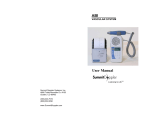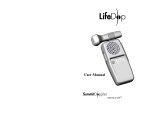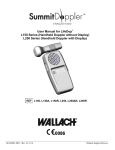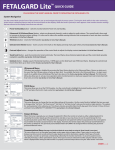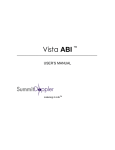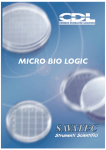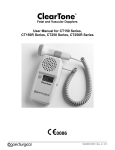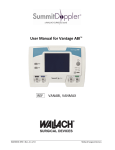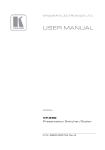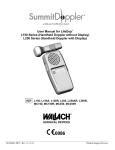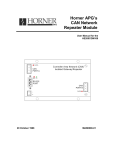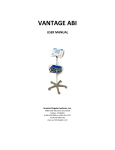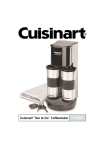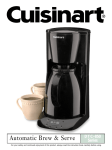Download ABI User Manual - Global Medical Solutions
Transcript
ABI VASCULAR SYSTEM User Manual Listening to LifeTM Thank you for choosing Summit Doppler Systems. We believe you have purchased the finest handheld Doppler and portable printer on the market. Your total satisfaction is our highest priority as we strive to continually improve our products and services. Please contact us with any suggestions. We look forward to enjoying a long-term relationship with you! Warranty and Servicing Policy Summit Doppler Systems, Inc. is pleased to present our customers with a 30day no hassle evaluation return policy in the event that you are not satisfied with our product. The warranty on this product is that it will be free from defects in material and workmanship for 12 months from the original sale of the device. This includes all parts and labor required to repair or replace the unit to original specifications and shipping costs associated with sending the product back to the customer. Customer is responsible for providing adequate packaging materials and shipping costs to Summit Doppler Systems. Products shall be repaired or replaced in a reasonable amount of time. Summit Doppler Systems, Inc. 4680 Table Mountain Dr. #150 Golden, CO 80403 Here’s how you can reach us… Phone: 1-800-554-5090 (303) 423-7572 Fax: (303) 940-7165 e-mail us at: [email protected] Visit our website at: www.SummitDoppler.com Summit Doppler Systems’ liability for any claim is limited to materials and labor associated with repair or replacement. In no event shall Summit Doppler Systems be liable for incidental or consequential losses or damages in connection with the purchase of this product. Table of Contents: Intended use/Contraindications/Warnings………... Description of product (table of features)………… Operation and Installation………………………… Obtaining Doppler Signals……………………….. Printer Operation………………………………..... Diagnostic Monitoring …………………………… Accessories……………………………………….. Maintenance/Cleaning……………………………. Replacing/Recharging Batteries………………….. Clinical References……………………….…...….. Specifications…………………...………………… Trouble shooting…………………………………. Warranty………………………………………….. Page 3 4 5 8 8 12 12 13 14 16 17 18 19 Please read the manual carefully and become familiar with the operation, features and maintenance of your Doppler prior to using the device or accessories. 0470 Authorized Representative BellyTalk BV Benedictijnenstr. 8 1566LB Assendelft Holland Summit Doppler Systems disclaims all express or implied warranties, agreements or arrangements other than issued in this warranty unless specified in writing and signed by the President of Summit Doppler Systems. Summit Doppler Systems is not responsible for damages to the device that occur as a result of the inadequate shipping to Summit Doppler Systems, improper maintenance or cleaning as described in the user manual, misuse, abuse, alteration of the equipment from it’s original specifications, or dismantling the unit (other than by Summit Doppler Systems approved service technicians). Service Returns: To return products to Summit Doppler – 1. Call Summit Doppler Systems to obtain a Return Authorization and to receive any final instructions prior to shipping 2. Clean the product prior to shipping 3. Ensure the device is well-packaged and suitable for shipment Send the product to: Service Department Summit Doppler Systems, Inc. 4680 Table Mountain Dr. #150 Golden, CO 80403 For customer service, technical service, cleaning, maintenance or shipping questions please call (303)423-7572 or 1-800-554-5090. Manual Part Number: MAN0007 Rev G 19 Transducer Model: LifeDop 5 MHz Bi-DirOperating Mode: Continuous-Wave (cw) Application(s): Peripheral Vascular ISPTA.3 ISPPA.3 ACOUSTIC OUTPUT MI (mW/cm2) (W/cm2) 500 0.5 32.7 5.50 0.32.7 5.50 (cm) 0.85 0.4 0.85 0.4 Beam Dimensions y-6 (cm) Az (cm) 0.6 0.4 0.6 EBD Ele. (cm) 0.8 Global Maximum Value Pr.3 wo fo Associated Acoustic Parameter zsp 0.05 0.12 (Mpa) (mW) (MHz) (cm) x-6 5.50 0.85 Transducer Model: LifeDop 8 MHz Bi-Dir Operating Mode: Continuous-Wave (cw) Application(s): Peripheral Vascular ISPTA.3 ISPPA.3 ACOUSTIC OUTPUT MI 2 Global Maximum Value Pr.3 wo Associated Acoustic Parameter ISPTA.3 ISPPA.3 MI Pr.3 Wo fc zsp x-6, y-6 EBD fo zsp 0.04 0.116 (Mpa) (mW) (MHz) (cm) 8.43 0.63 Beam Dimensions x-6 y-6 (cm) (cm) EBD Az (cm) Ele. (cm) 2 (mW/cm ) (W/cm ) 365 0.37 15.7 8.43 0.63 0.42 0.14 0.6 0.3 15.7 8.43 0.63 0.42 0.14 the derated spatial-peak temporal-average intensity (mwatts per cm2). the derated spatial-peak pulse-average intensity (watts per cm2). the Mechanical Index. the peak rarefactional pressure (megapascals) associated with the transmit pattern giving rise to the value reported for MI. the total time-average ultrasonic power (mwatts). the probe center frequency (MHz). the axial distance at which the reported parameter is measured (cm). are the –6dB beam dim. in the x-y plane where zsp is found (cm). the entrance beam dimensions (cm). These dimensions are the same as the dimensions of the transmit crystal. Measurement Uncertainties: Power: Pressure: Intensity (Ispta): Frequency: +34, -42% +11, -16% +23, -26% +/- 5% Acoustic Output Parameters are measured in water. Derated values, denoted by the subscript “.3”, take into account a conservative level of attenuation that would be encountered in the human body. The derated intensity values (I.3) are obtained from water values of intensity (Iw) at a depth of z calculated by: I.3 = exp(-0.23*0.3*f*z)*Iw (where f is the probe frequency in MHz and z is the depth in centimeters) The derated peak rarefactional pressure is calculated from the value of measure water (pr) by: Pr.3 = exp(-0.115*0.3*f*z)*pr (where pressure is given in megapascals) Additional Output Reporting Information for IEC 61157 8 MHz: Iob < 112 mW/cm2 Note that parameter Zsp in the probe reporting tables is the same parameter as Ip in IEC 61157. Operating Conditions: There are no user controls which affect the ultrasound output. 18 Summit Doppler Systems, Inc. provides general reimbursement information related to the diagnosis of peripheral arterial disease as an overview for our customers. It is important to understand that reimbursement is a complex process and requirements are subject to change without notice. It is the responsibility of the healthcare provider to determine and submit appropriate codes, charges, and modifiers for services that are rendered. Prior to filing any claims, customers are advised to contact their third-party payers for specific coverage, coding and payment information. Summit Doppler Systems, Inc. makes no promise or guarantee of reimbursement by Medicare or any other third-party payer. Intended Use This product will be used to detect blood flow in veins and arteries for assisting in the detection of peripheral vascular disease. Federal law restricts this device to sale by or on the order of a licensed practitioner. Contraindications Warning: The vascular probes are not for fetal use. Warning: The ultrasound probes are not to be used on or near the eyes. Warning: The device is for use only on intact skin. Warning: Do not plug any part of this device into a telephone or modem. Warning: This device is not intended for use with HF surgical equipment. If there are questions or concerns regarding these warnings or contraindications, please do not hesitate to contact Summit Doppler Systems for further clarification. In order to preserve, protect and improve the quality of the environment, protect human health and utilize natural resources prudently and rationally – do not dispose of waste electrical or electronic equipment (WEEE) as unsorted municipal waste. Contact local WEEE disposal sites or Summit Doppler Systems to dispose or equipment. Safety of Ultrasound The Summit Doppler was designed with physician and patient safety in mind. In early design phases all potential hazards were eliminated or reduced to As Low As Reasonably Achievable (ALARA) by adhering to good design practices and industry wide safety standards. Ultrasound procedures should be performed with the ALARA principle in mind when delivering ultrasound energy into the body. 3 The following official statements from the American Institute of Ultrasound Medicine (AIUM) are provided for your general information regarding the safe use of ultrasound. Clinical Safety Approved March 1997, October 1982 Diagnostic ultrasound has been in use since the late 1950s. Given its known benefits and recognized efficacy for medical diagnosis, including use during human pregnancy, the American Institute of Ultrasound in Medicine herein addresses the clinical safety of such use: There are no confirmed biological effects on patients or instrument operators caused by exposures from present diagnostic ultrasound instruments. Although the possibility exists that such biological effects may be identified in the future, current data indicate that the benefits to patients of the prudent use of diagnostic ultrasound outweigh the risks, if any, that may be present. Prudent Use Approved May 1999 The AIUM advocates the responsible use of diagnostic ultrasound. The AIUM strongly discourages the non-medical use of ultrasound for psychosocial or entertainment purposes. The use of either two-dimensional (2D) or three-dimensional (3D) ultrasound to only view the fetus, obtain a picture of the fetus or determine the fetal gender without a medical indication is inappropriate and contrary to responsible medical practice. Although there are no confirmed biological effects on patients caused by exposures from present diagnostic ultrasound instruments, the possibility exists that such biological effects may be identified in the future. Thus ultrasound should be used in a prudent manner to provide medical benefit to the patient. Safety in Training and Research Approved March 1997, March 1983 Diagnostic ultrasound has been in use since the late 1950s. There are no confirmed adverse biological effects on patients resulting from this usage. Although no hazard has been identified that would preclude the prudent and conservative use of diagnostic ultrasound in education and research, experience from normal diagnostic practice may or may not be relevant to extended exposure times and altered exposure conditions. It is therefore considered appropriate to make the following recommendation: In those special situations in which examinations are to be carried out for purposes other than direct medical benefit to the individual being examined, the subject should be informed of the anticipated exposure conditions, and of how these compare with conditions for normal diagnostic practice. 4 Specifications Degree of protection against electric shock: Type B Applied part Class II Equipment Degree of protection against ingress of water: IPX4 – extending 2.5 cm from tip IPX1 – entire probe 2.5 cm from tip, excluding connector Designed and tested to meet: IEC601-1, IEC60601-1-2, IEC60601-1-4, IEC60601-2-37, EN5011-A Connect the LifeDop only to equipment that meets the appropriate standards. Dimensions (h w l): Weight: LifeDop 140x70x35 mm 320 grams Printer 136x84x43 mm 280 grams Operating temperature: 10 to 40 C 0 to 40 C Operating humidity: 30 to 75 % 20 to 85 % Transport/Storage temp: –20 to 50 C –20 to 60 C Transport/Storage humidity: 5 to 90%, non-condensing for both units (beyond 30 days, battery to be stored between –20 and 30 C) Battery life Battery voltage, type LifeDop 100, 4-minute exams AA Alkaline 1.5V x3 Printer 500 prints Lithium Ion 3.7V Audio bandwidth and power: Audio cable pin out: 245 Hz – 4 KHz, 0.33 W 3.5 mm stereo plug Tip - toward, Ring - away, Shaft – common Note: Common is not a ground connection Printer Paper Type/Size (max): Printer Speed: Printer Resolution: Printer Impact Resistance: Printer Communication: Thermal, 58mm wide, 33mm diameter 35mm/sec, 8 seconds for standard printout 48mm wide, 8 dots/mm, 384 dots/line 1.5 meter on linoleum floor RS232, 8 data bits, 1 stop bit, no parity, 115.2Kbaud Input – 100-120VAC, 29VA, 50/60Hz Output – 5VDC, 2.3A, center positive Auto scaled to max 4KHz, 2KHz and 1KHz 25mm/sec, 100 mm length w/ 4 sec of data 175 mm total with header Printer Recharger: Waveform Frequency Scale Waveform Time Scale Printout Length Attention: Consult Accompanying Documents Additional technical information is available upon customer request. 17 Printer Not Printing (Error 9) The LifeDop and printer have lost communication. This may be due to a printer jam, paper empty, low printer battery or any of the above printer error codes. To clear the error, lift the paper cover lever, reseat the paper roll and close the cover. If printer communication is re-established, the LifeDop will automatically print the buffered waveform. If Error 9 persists, turn off both printer and LifeDop and re-start waveform buffer. Waveform appears to be the same above and below the base line This anomaly normally occurs when the probe is close to perpendicular to the vessel. Reacquire the Doppler signal with the probe angle at 45 degrees as described in Obtaining Doppler Signals. Description of product The Summit LifeDop ABI is factory configured to include many features and product enhancements. Along with interchangeable ultrasound transducers, the Summit Doppler device is well suited to meet your specific needs. Main Unit The main handheld unit is ergonomically designed to fit the palm of your hand with comfort and allow easy access to each control feature. Each unit is individually tested and inspected to ensure the highest quality standards. Printer Download – The LifeDop buffers 4 seconds of waveform data and waits until the printer is ready to print out a record of the examination. Faint signal is audible, but waveform is not obtained on printout The LifeDop main unit is designed to reject noise and certain artifacts. Even a valid signal must reach a threshold before it can be printed; therefore it is normal for some very weak signals to be rejected. LCD Display – The LCD display allows you to view information in large easy to read digits including probe ID, battery life, signal strength indicators, and multiple diagnostic indicators that ensure your unit is functioning at peak performance levels. Printer Switches not set in proper location The printer switches have been preset at the factory to the proper location, however if they have been changed the printer will not function. Orient the printer and set the DIP switches to match the following: SSQ – Superior Sound Quality. LifeDop ABI is designed with a state of the art sound system that produces excellent sound quality and long-term reliability. 1 – Up 2 – Down 3 – Down 4 – Down Reference materials for Peripheral Vascular testing: Noninvasive Diag of Peripheral Vascular Disease; W. Robert Felix, Jr., 1988 Current Noninvasive Vascular Diagnosis; Ali F. Aburahma, Edward B. Diethrich, 1988 Vascular Disease Foundation; www.vdf.org American Heart Association; www.americanheart.org American Diabetes Association; www.diabetes.org 16 Main Unit Catalog# L250ABI SSQ X Feature Display Download X X Probe Summit Doppler ultrasound transducers were designed to meet your specific application need. Each probe has been ergonomically designed for comfort while providing excellent maneuverability for locating the vascular target. Every probe is carefully measured and tested to ensure it meets exacting performance standards. 8 MHz Directional Probe – This standard “pencil” style probe is an excellent vascular tool for locating specific shallow vessels in the peripheral vascular system. The narrow grip and small face of the probe make it ideal for maneuvering for maximizing the signal in both flow directions. 5 MHz Directional Probe – This “pencil” style probe, with wide beam and deep penetration, is designed for locating deep vessels in the peripheral vascular system. The narrow grip is easy to maneuver. Probe Catalog # SD8B 8 MHz Bi-Dir SD5B 5 MHz Bi-Dir Application PV ABI PV General X X X X 5 Operation and Installation Trouble shooting Warning: Use alternate equipment in case of unit failure. Call Summit Doppler Systems Service Department if the probe or main unit malfunctions. Warning: Do not drop or mishandle the LifeDop, probes or accessories. Damage to sensitive electrical components, speakers, cables, transducers or plastic likely to occur. PROBE CONNECTOR HEADPHONE CONNECTOR Poor sound quality Inadequate gel use Try and relocate the probe for a better signal Improper choice of probe Frequency Interference from other equipment Probe coiled cable or battery contacts may be intermittent Debris in the speaker may cause poor sound Device damage from dropping the LifeDop, probes or accessories PRINTER CONNECTOR Battery indicator flashing – Error 5 or Error 7 Consult Diagnostic Monitoring, replace batteries as described in Replacing Batteries PRINT BUTTON Probe frequency does not match the connected probe Check probe that is attached to ensure it is the correct one, or no probe attached If correct probe, contact Summit Service Side Panel Controls Radio Frequency Interference The LifeDop was tested for immunity to electromagnetic interference at a level of 3V/meter. Interference during normal operation may occur in the presence of fields stronger than 3V/meter. If this occurs, try to increase the distance between the LifeDop and the source of interference. Contact Summit Doppler for more information. Printer LED Red or Orange Green Orange Red LED LED LED Flash 2x Flash Flash 1x Flash 2x Flash 3x Flash 4x Error Solution No Error Low Battery Out of Paper Open Cover Thermal Failure Voltage Failure Normal Recharge Reload Paper Close Cover Call Summit Call Summit Printer DIP switches are preset at the factory. The printer will not function properly if they are moved from these set positions. 6 15 Replacing LifeDop Batteries (NOT USED) Warning: Replace batteries only with batteries supplied by Summit Doppler Systems. The battery compartment only accepts AA size batteries. See accessories list for part number and re-order information. (NOT USED) Open the battery compartment by depressing the tab and pulling outward on the battery door. Remove the existing drained batteries by pushing on the end of the battery that compresses the battery contact spring and lift upwards. It is acceptable to use a small tool or pen to assist in this step. (NOT USED) LCD Display Replace the batteries by paying close attention to the polarity indicators on the battery and the polarity indicators on the battery holder in the compartment. Positive (+) aligns with positive (button) and negative (-) aligns with negative (spring). Insert the battery such that the spring contacts are loaded first and then press the battery firmly into place. Warning: If the batteries have been inserted incorrectly, the unit will not function but the LifeDop will not be damaged. (NOT USED) Recharging Printer Batteries Warning: Use only the battery and AC adapter supplied with the printer. Use of any other battery and/or AC adapter is hazardous and may cause damage to the equipment. (NOT USED) A comprehensive In-Service Training Video is now available. Warning: Do not connect the printer to the Doppler while the printer is charging. Printer Recharger 14 Turn the printer off. Lift the rubber flap on the left side of the printer and plug in the connector of the recharge adaptor. Make sure recharger is plugged into a standard 120VAC outlet. When properly connected, the LED will be red. Upon completion of charging the LED will be green. Remove the recharger and replace the rubber flap Turning Unit On/Off Turn the LifeDop on by pressing the On/Off button. LCD indicators show power status. The LifeDop automatically shuts itself off after 5 minutes if it is not being used. Turn the Printer on by pressing and holding the On/Off button until the green LED comes on (approximately 3 seconds). Printer automatically shuts itself off after 30 minutes. Volume Slider The audio level can be adjusted using the Volume Slider. Moving the slider up will increase the volume, while moving it down will decrease it. The volume slider does not affect the headphone output. 7 Obtaining Doppler Signals and Printer Operation Caution: Doppler examinations should be performed only by trained individuals. For any Doppler examination, it is essential that an adequate supply of coupling gel be used to transmit the ultrasound energy from the probe to the surface of the skin. Re-apply more gel if it starts to dry out or spread so thinly that an air gap occurs between the probe and the skin. It is not necessary to cover the entire surface of the probe, only the probe face. Applying too much gel makes the unit difficult to clean and does not aid in the performance of the probe. For the best results, angle the probe approximately 45 degrees from the skin surface over the general location of the vessel. Slowly move the probe side to side and vary the angle of the probe until the vascular sounds are heard. Changing the angle of the probe has an affect on the frequency of the sound. The steeper the probe angle, the higher the frequency of the sound. Maintenance and Cleaning Warning: The LifeDop is not designed for liquid immersion. Do not soak or drop the Doppler main unit or probes in liquids. Use only spray or wipe cleaners and disinfectants. Warning: The LifeDop is not designed for sterilization processes such as autoclaving or gamma radiation. Warning: The LifeDop is not intended to be used on open skin. If there is evidence of open wound contamination, disinfect the probe before using again as described below. The LifeDop Doppler requires very little maintenance. However, it is important to continuing function of the unit and the health of the patients that the unit is cleaned and examined regularly per the following guideline: After every examination: Excess gel should be wiped off prior to docking the probe. Probes and main unit should be cleaned with a damp warm water cloth or presaturated isopropyl alcohol wipes or spray such as Transeptic® from Parker Laboratories, Inc. In particular, pay close attention to clean the seams along the plastic lines at the probe face but do not allow water or spray to enter through the connectors or speaker grill. To disinfect unit, use commercially available spray or wipe disinfectants registered with the EPA – such as Precise® QTB from Caltech Industries, Inc. Follow the manufacturers instructions and wipe unit until it is dry of solutions. Examiners should wash hands and change gloves after every exam. Refer to local and hospital policies for cleaning and disinfection policies. Signal Quality Indicator Once flow sounds are found, the signal strength indicators give the user a visual display of the flow direction and relative strength of the signal. Four bars of the left indicate flow toward the probe, while the four bars to the right indicate flow away from the probe. Vary the probe position and angle as described above while viewing the indicators to obtain the best results. Buffering a Waveform Once the desired flow is found, press the red “PRINT” button on the side of the unit to buffer the PREVIOUS four seconds of flow. When the waveform is buffered, as indicated by “STR” on the display, the probe is temporarily shut off and can be removed from the patient. The printer need not be connected to buffer the waveform - the LifeDop waits until the printer is ready. Store unit in a clean area free from dust and debris. Follow temperature and humidity guidelines as specified at the end of this manual. Warning: If the unit is to be stored for longer than 90 days without use, remove the batteries prior to storage. Periodically (at least annually): Inspect the main unit and probes for signs of cracks or breaks in the mechanical housing. Inspect cables and connectors for signs of wear or failure. The user should discontinue use of the unit with any sign of loss of housing integrity. Contact Summit Doppler Systems for service. It is recommended that rechargeable batteries be replaced annually. Note: Only one waveform can be buffered at a time and the LifeDop must remain ON in order to retain the waveform. 8 13 Diagnostic Monitoring All LifeDop Doppler units perform continuous diagnostic monitoring and give a visual indication of battery level. The LifeDop uses a multiple level battery shaped icon that indicates the voltage level of the battery. The battery outline will flash when the battery level is very low indicating that the user should change the batteries soon after the current examination is complete. Once the unit is on, the LifeDop performs a series of diagnostic checks. The unit first checks and displays the frequency of the probe that is being used. This display will not change unless the probe is changed or the power is cycled, in which case the display will again temporarily confirm the frequency of probe that is connected. Connecting the Printer Ensure that the printer is loaded with paper and connect the cable to the printer and LifeDop as shown, with connector tabs down as labeled “THIS SIDE UP”. Turn the printer on by HOLDING the power button down (approx. 3 seconds) until the LED comes on. If the printer is functioning properly and ready to print, the LED will flash green twice every second. Warning: Forcing the cable upside down will cause damage to the connector pins on the LifeDop, cable and printer. Note label “THIS SIDE UP”. Note: When turning the printer on or off, it is important to remember to hold the button down, approximately 3 seconds, before the printer will respond. The unit then checks for proper internal operating temperature, battery voltage, reference voltage and power supply voltage levels. If any of these characteristics are out of range, the display will show the ERROR icon and a failure code associated with the diagnostic error. Diagnostic functions are periodically checked while the unit is on to ensure the Doppler is operating at peak performance. Refer to the table below for failure codes. Diagnostic Codes – Contact Summit Service 1 – Temperature too low 5 – 5 Volt Supply too low 2 – Temperature too high 6 – 5 Volt Supply too high 3 – Reference Voltage too low 7 – Battery Voltage too low 4 – Reference Voltage too high 8 – Battery Voltage too high 9 – Printer miscommunication The printer will perform a self-test print by turning the printer on while the feed button is being held down. A checkered test pattern will print in addition to the printer configuration and loaded fonts. Loading Paper Warning: Install the paper roll in the printer so the external side (heat sensitive side) of the rolled paper is against the print head (down). Warning: Do not use printer paper other than the type specified and supplied by Summit Doppler. Other paper types could result in damage or degraded print quality and may void the warranty. Accessories Contact Summit Service at 1-800-554-5090 or (303) 423-7572 to order by phone, or order on-line on our website www.SummitDoppler.com Description Alkaline battery Lithium Ion battery Carry Case User Manual Quick Reference Guide ABI Assessment Form ABI In-Service Video 12 Part Number BAT0002 BAT0004 PKG0003 MAN0007 MAN0008 MKT0042 MKT0076 Description Part Number Coiled Cable CBL0001 Printer Cable CBL0011 Gel (60 gm) GEL0001 Gel (250 gm) GEL0002 Printer Paper (Labels) MMH0014 Printer Paper (10 yr) MMH0015 Printer Connections 9 Printing a Waveform Report Generation Warning: The print head becomes hot during printing. Do not touch the print head after printing. Report generation is made very simple with adhesive backed printer paper provided by Summit Doppler - eliminating the need to cut and tape the strip of paper. The label paper backing is precut down the center – fold the paper down the middle and peal from the center. Attach the waveform to the preprinted ABI assessment Form. Warning: Turn off the printer and check that the head is fully cooled before attempting to fix a paper jam, replacing paper, or removing the print roller for any reason. Once the printer is operational and the cables are in place, the LifeDop will automatically download the waveform and printing will begin. If the PRINT button is pressed while the printer is connected and ready, printing will start immediately. Waveforms are automatically scaled to a maximum frequency of either 1 KHz, 2 KHz or 4 KHz for optimal waveform height. Markings on the vertical axis are provided every 1 KHz. Printer calibration is not required. Auto-Scaling – 1 kHz, 2 kHz and 4 kHz Printout Blood flow in the direction toward the probe is shown above the baseline. Flow away from the probe is shown below the baseline. These two traces are provided so that flow in both directions can be displayed simultaneously. ABI Assessment Form 11 10










